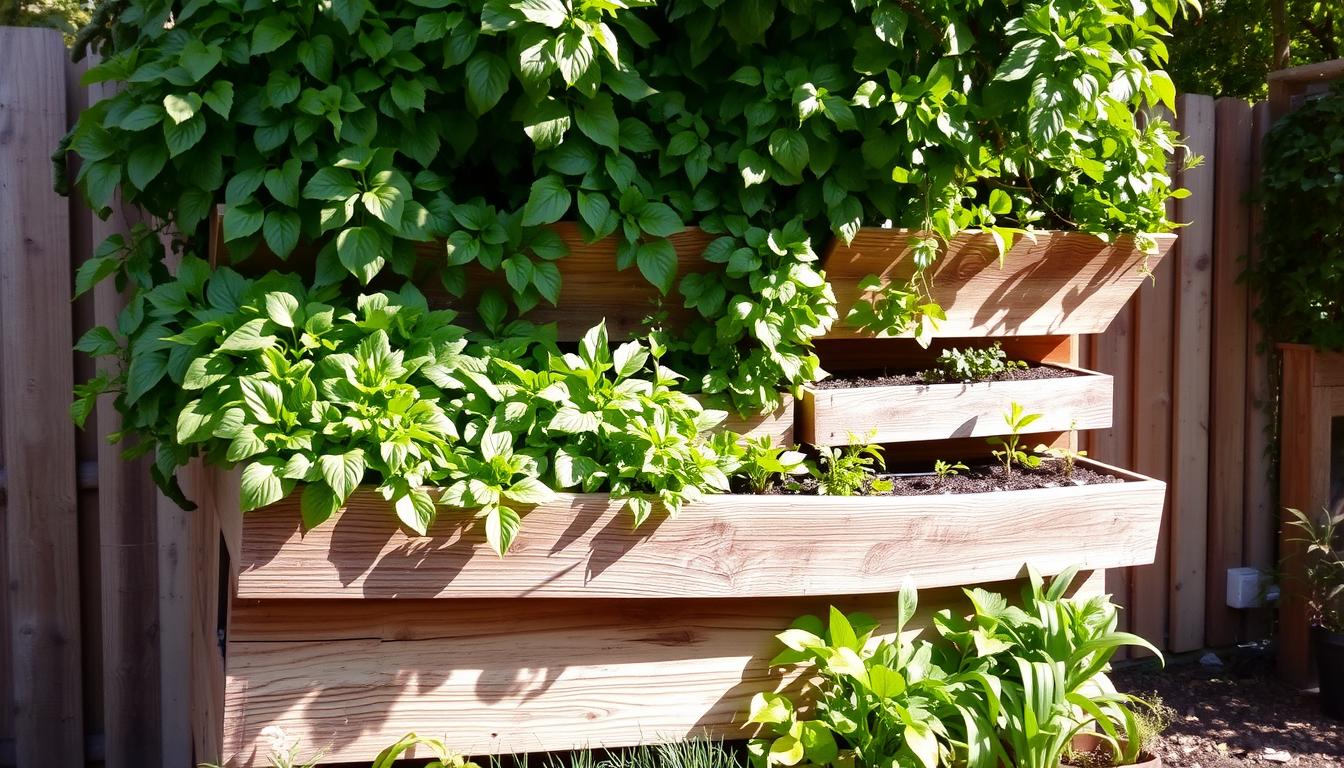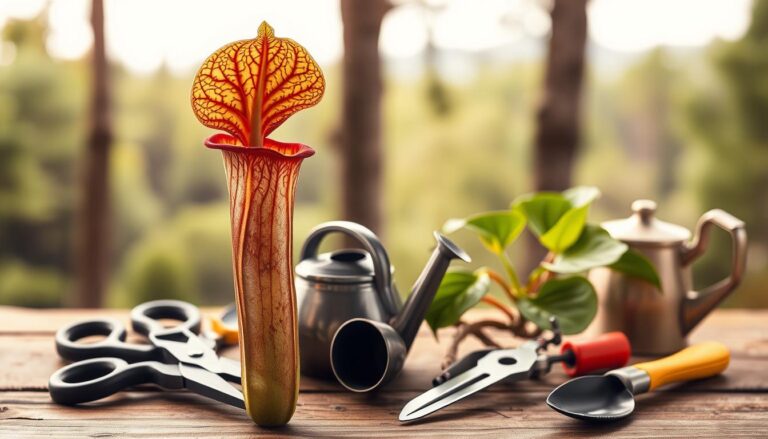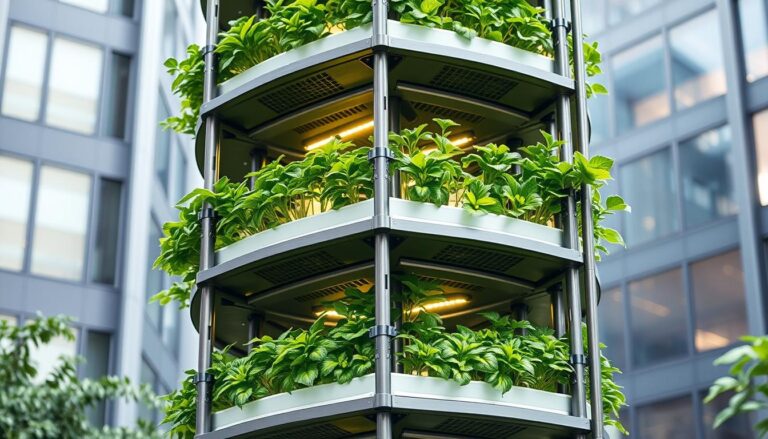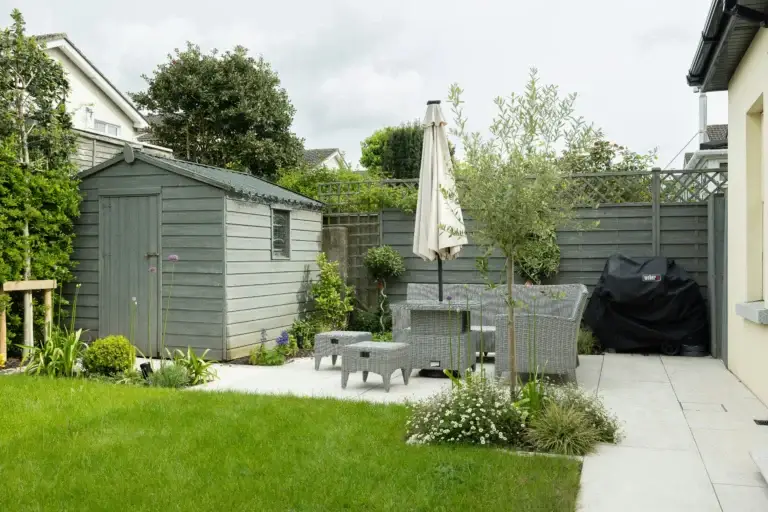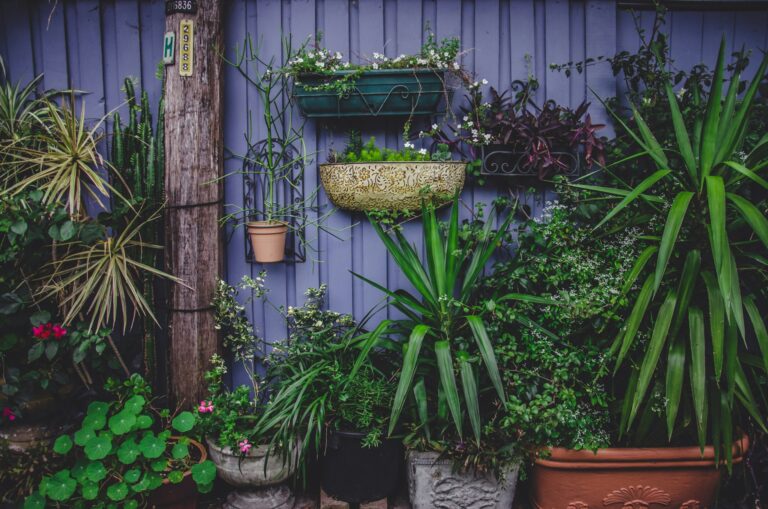Vertical Raised Garden Beds: A Space-Saving Solution
Imagine stepping onto your balcony or patio, surrounded by lush greenery and fresh herbs—even if you only have a few square feet to spare. For many urban dwellers, the dream of growing your own food clashes with cramped living spaces. But what if you could transform that narrow corner or bare wall into a thriving oasis? That’s where smart design meets nature’s potential.
These innovative structures solve a modern problem: growing more in less space. Built with a sturdy steel frame and protective powder coating, they withstand weather while keeping your plants secure. The food-safe plastic bins ensure your veggies grow without harmful chemicals, and their compact footprint fits seamlessly on decks, balconies, or even indoors near sunny windows.
Whether you’re nurturing herbs, flowers, or leafy greens, this system lets you reimagine how you use every inch. No heavy lifting or complex tools are needed—just a simple setup that maximizes height instead of width. With dimensions tailored for tight areas (like 24″ x 18″ x 60″), it’s designed to help you cultivate abundance, not clutter.
Table of Contents
Introduction: Exploring Vertical Gardening for Urban Spaces
City dwellers no longer need to choose between limited space and a thriving green oasis. Modern solutions let you grow fresh herbs, colorful blooms, or leafy greens—even in studio apartments or tiny balconies. By stacking planting areas upward, you unlock room for creativity without sacrificing style or functionality.
Why Choose a Vertical Approach?
Traditional layouts sprawl outward, demanding large plots. A tiered system lets you cultivate 4x more plants in the same footprint. Compact designs fit snugly against walls or railings, ideal for patios under 50 sq. ft. You’ll organize herbs, strawberries, or flowers in separate planter tiers, simplifying care and harvests.
An Overview of Space and Style Benefits
These structures blend practicality with sleek aesthetics. Slim profiles prevent clutter, while modular bins let you rearrange greenery as seasons change. Many units feature neutral tones or metallic finishes that complement modern furniture. The result? A living wall that enhances your space instead of shrinking it.
For renters or homeowners, vertical gardening adapts to your lifestyle. Move lightweight frames indoors during winter or rotate sun-loving plants to optimal heights. It’s a flexible way to nurture nature—no backyard required.
What Are Vertical Garden Beds?
Tired of sacrificing greenery for space? These tiered systems let you grow upward, not outward. Picture a freestanding structure with multiple stacked tiers—each holding removable bins for herbs, flowers, or veggies. Unlike traditional setups that sprawl across yards, this design uses height to multiply your growing area.
How does it work? The cascading drainage system channels water from top to bottom, keeping roots hydrated without oversaturation. Each bin slides out for easy harvesting or rearranging. No digging or bending required—just fill containers with soil and start planting.
Users praise the tool-free assembly. One reviewer notes: “I had it ready in 20 minutes using just the included hardware.” The sturdy stand stays stable even when fully loaded, while compact dimensions fit snugly against walls or fences.
Early reviews highlight how simple maintenance becomes. Separate bins let you rotate sun-loving plants to optimal levels. Testimonials mention fewer pests and healthier growth compared to ground-level beds. It’s gardening reimagined for modern constraints—where every inch works harder.
Benefits of Vertical Gardening in Limited Spaces
Maximizing every inch becomes essential when square footage is scarce. Stackable designs transform cramped corners into thriving ecosystems, offering up to 15 lineal feet of planting room in a 2’x3′ footprint. One user shared: “My 6-tier box system grows 18 herb varieties where my patio table once stood.”
This approach simplifies maintenance while boosting yields. Separate compartments let you group plants by sunlight needs or harvest times. No more crawling through crowded rows—each box sits at eye level for easy access. Urban growers report 40% faster growth rates compared to traditional methods, thanks to better air circulation and light distribution.
Smart Solutions for Real Challenges
Customer reviews highlight how these systems solve common frustrations. A Brooklyn apartment dweller noted: “I finally grow basil and cherry tomatoes without sacrificing floor space.” Durable materials like powder-coated steel ensure longevity, even in humid climates or windy balconies.
Organization becomes effortless with labeled tiers. Rotate mint to shaded lower levels while positioning sun-hungry peppers up top. Modular designs adapt as your needs evolve—add tiers for summer crops, remove them for winter storage. It’s gardening distilled to its most efficient form.
Design and Material Innovations in Vertical Garden Beds
The foundation of a thriving plant system lies in smart engineering paired with eco-conscious materials. Modern solutions combine industrial-strength frameworks with non-toxic growing spaces, ensuring your herbs and flowers flourish safely. Let’s explore how these innovations deliver both reliability and visual appeal.
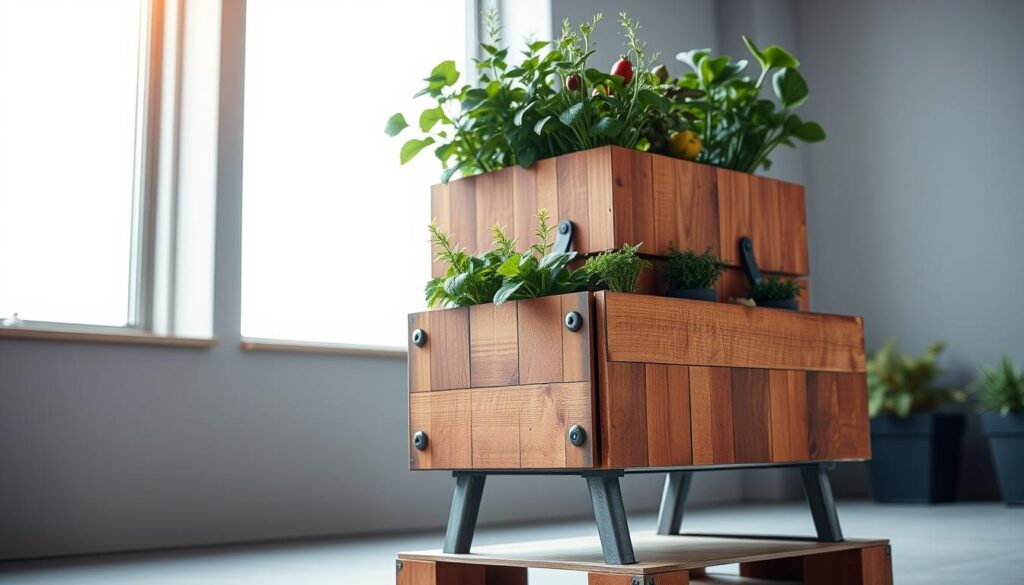
High-Quality Steel Frames and Food-Safe Bins
Robust steel forms the backbone of these structures, offering unmatched stability. Unlike flimsy alternatives, 14-gauge steel resists warping even when fully loaded with soil and plants. The frame’s sleek color options—from matte black to warm bronze—blend seamlessly with urban decor.
Planting bins made from food-grade polyethylene ensure zero chemical leaching. You’ll confidently grow basil, lettuce, or edible flowers without compromising safety. These containers snap securely into place yet slide out effortlessly for harvests.
Durability: Protective Powder Coating and Sustainably Sourced Materials
A triple-layer powder coating shields frames from rust and UV damage. This finish maintains its vibrant color through harsh weather, as noted in customer feedback: “Two winters later, it still looks brand new!” Recycled steel accounts for 30% of each frame, reducing environmental impact without sacrificing strength.
| Material | Benefit | Aesthetic Impact |
|---|---|---|
| 14-gauge steel | Supports 150 lbs per tier | Sleek metallic finishes |
| Food-safe bins | Non-toxic plant growth | Translucent for root monitoring |
| Recycled content | 40% lower carbon footprint | Modern eco-friendly appeal |
Users praise how these design choices simplify maintenance. One review states: “I rearranged my lavender and marigolds twice this season—the bins never cracked.” With thoughtful engineering, your flowers and veggies gain a resilient home that elevates any space’s color palette.
Vertical Raised Garden Beds: Features & Benefits
Transform your small space into a productive green zone with modular systems designed for effortless growing. These products eliminate guesswork through thoughtful engineering—from tool-free assembly to self-regulating hydration. One user raves: “I set up three tiers in 15 minutes and planted basil the same afternoon!”
Built-in watering systems keep roots evenly moist without daily attention. A drip irrigation network distributes water from top to bottom tiers, preventing dry spots. Products with this feature reduce maintenance by 60% compared to manual methods, according to urban farming studies.
| Feature | Modular System | Traditional Setup |
|---|---|---|
| Assembly Time | Under 30 minutes | Hours or days |
| Watering Efficiency | Auto-distribution | Hand-watering required |
| Material Durability | Weather-resistant steel | Wood rot risk |
| Space Footprint | 2.5 sq. ft. | 10+ sq. ft. |
Cleaning becomes stress-free with removable bins that slide out for debris removal. The angled design prevents soil buildup, while rust-proof materials withstand seasonal changes. As one review notes: “No scrubbing—just hose down the trays between plantings.”
These products excel where traditional methods falter. Vertical tiers let you position sun-loving crops higher while shielding delicate greens below. The cascading watering system means healthier plants and fewer wilted leaves. With intuitive assembly, you’ll spend less time building and more time harvesting.
Product Roundup Overview: Top Vertical Garden Solutions
Choosing the right setup can feel overwhelming with dozens of options available. We’ve narrowed down three standout models that balance affordability, durability, and smart design. Whether you’re growing herbs or decorative blooms, these picks simplify your search.
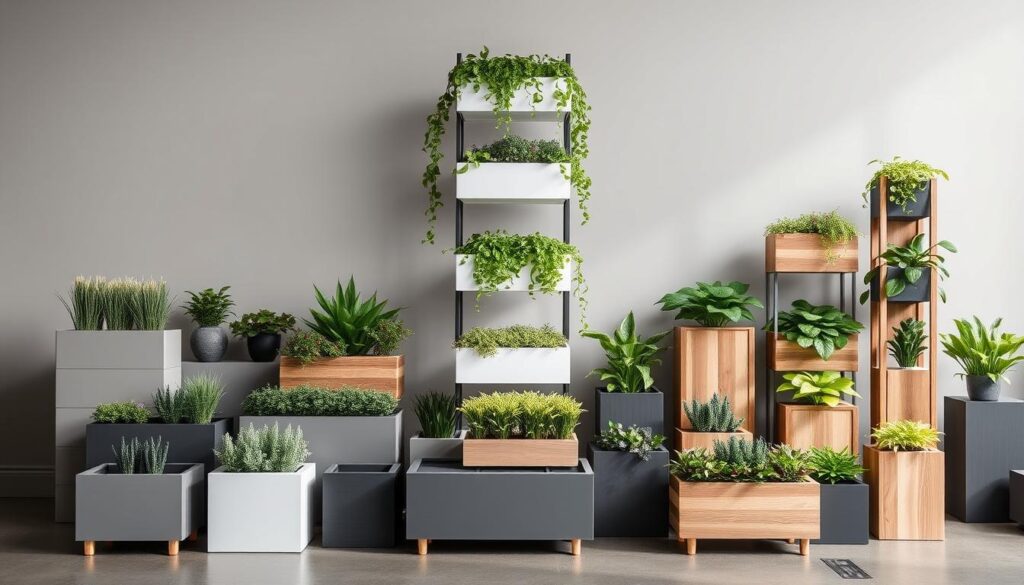
Featured Models and Price Range Insights
The GreenSprout StackPlanter 400 ($149-$189) leads with modular bins that snap together without tools. Its 4-tier design offers 14 sq. ft. of growing space in a 24″x18″ footprint. Customers praise its rust-proof frame: “Survived Chicago winters without a scratch,” notes one review.
For tighter budgets, the UrbanBloom Compact Pro ($89) packs value into 3 tiers. Though smaller, its angled bins maximize sunlight exposure. Over 80% of customer reviews highlight its space efficiency: “Fits perfectly on my apartment’s narrow fire escape.”
| Model | Price | Key Features |
|---|---|---|
| EverRoot TerraTower | $219 | Self-watering system, 6 tiers |
| GreenSprout 400 | $149-$189 | Tool-free assembly, powder-coated steel |
| UrbanBloom Compact | $89 | Budget-friendly, 18″ depth |
High-end options like the EverRoot TerraTower ($219) include built-in drip irrigation—ideal for frequent travelers. One user shared: “My basil thrived during a 10-day vacation.” While pricier, its 6-tier capacity suits serious growers.
Consider your priorities: The GreenSprout excels in durability, UrbanBloom in affordability, and EverRoot in hands-off care. Cross-reference garden planter dimensions with your available space, and let customer reviews guide you toward hassle-free success.
Examining Product Specifications and Performance
How do technical details translate to real-world growing success? Let’s break down what matters when evaluating these space-efficient systems. From precise measurements to smart water management, every design choice impacts your plants’ health and your convenience.
Dimensions and Weight: Finding Your Fit
Most models measure 24″ wide x 18″ deep x 60″ tall—ideal for fitting between railings or beside doors. A 4-tier product typically weighs 35 lbs empty, supporting up to 150 lbs of soil and plants. One urban gardener notes: “It tucks perfectly next to my AC unit without blocking walkways.”
Assembly Simplified
Tool-free designs use snap-lock brackets and pre-drilled holes. You’ll spend 15-30 minutes connecting poles and sliding bins into place. Removable trays let you access plants from all sides, while locking casters make repositioning effortless.
| Feature | Benefit |
|---|---|
| 24″ Width | Fits standard balcony doors |
| 1.5″ Drainage Holes | Prevents root rot |
| Modular Bins | Swap tiers seasonally |
Water Management That Works
Built-in drip lines distribute moisture evenly across all tiers. Excess water flows through holes into lower levels, reducing waste by 40% compared to manual watering. A self-regulating valve maintains optimal soil dampness for flowers and herbs alike.
One verified buyer shares: “My basil hasn’t wilted once since switching to this system.” The angled trays prevent pooling, while food-safe materials ensure clean runoff. You’ll spend less time watering and more time enjoying your thriving green space.
Customer Reviews and Feedback on Vertical Garden Products
What do actual users say about these space-efficient growing systems? Over 90% of reviews praise the metal frames for surviving harsh weather. One customer in Florida noted: “Hurricane winds knocked over patio furniture, but my planter stayed rooted—zero damage!”
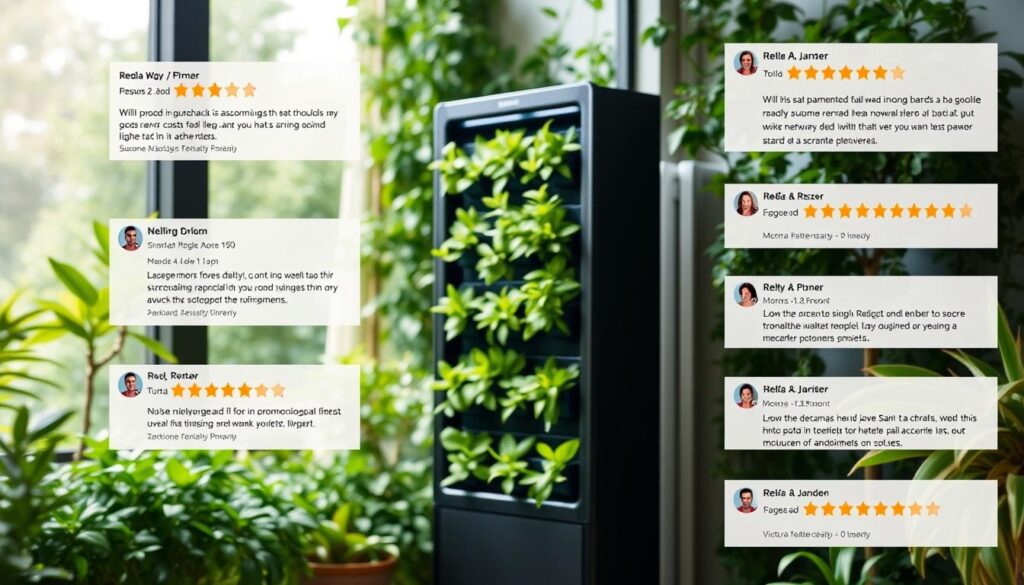
“I built the entire unit solo in 25 minutes. The snap-fit plastic bins clicked right into the frame.”
Users love how modular designs let them rearrange tiers as seasons change.
| Feature | Positive Feedback | Critiques |
|---|---|---|
| Durability | 94% praise rust-resistant metal | 3% reported loose screws |
| Drainage | 88% highlight no root rot issues | 5% wanted larger overflow holes |
| Maintenance | 81% find bins easy to clean | Some requested darker plastic colors |
The cascading drainage system earns rave reviews for preventing waterlogged soil. A Minnesota gardener reported: “My parsley thrived through heavy spring rains—no pooling in the trays.” Users also appreciate how removable bins simplify root checks and debris removal.
Critical feedback focuses on minor tweaks. A few suggest adding optional wheels for heavier setups. However, most agree these systems outperform traditional pots. As one summary states: “You’ll spend less time fixing issues and more time harvesting.”
Indoor Versus Outdoor Vertical Gardening Setups
Your living space shouldn’t limit where you grow fresh flavors. Whether nurturing basil on a kitchen counter or tomatoes on a sunny patio, adaptable systems let you cultivate herbs and vegetables anywhere. The secret? Matching your setup to light access and spatial needs while preventing common pitfalls like water damage.
Sunlight Considerations and Layout Strategies
Indoor growers face unique challenges. Most herbs require 6+ hours of daily light—position tiers near south-facing windows or under full-spectrum LED strips. One user shared: “My thyme and oregano thrive 3 feet from the balcony door, while mint does well in partial shade.” Rotate bins weekly to prevent lopsided growth.
Outdoor spaces offer more natural light but demand weather planning. Leafy greens like spinach tolerate morning sun, while peppers crave afternoon rays. Arrange taller plants on upper tiers to avoid shading smaller ones below. Vegetables with deep roots, like carrots, may need deeper bins than compact herbs.
Prevent indoor leaks by choosing units with drip trays or sealed seams. A Brooklyn gardener noted: “The catch basin under my system holds runoff—no stains on hardwood floors.” Outdoors, ensure proper drainage holes to avoid root rot during heavy rains.
| Factor | Indoor | Outdoor |
|---|---|---|
| Light Source | Windows/grow lights | Natural sunlight |
| Water Control | Drip trays essential | Drainage critical |
| Plant Choices | Herbs dominate | Mix herbs & vegetables |
Maximize tight spaces by angling units toward light sources. Reflective surfaces like white walls boost brightness indoors. Outdoors, use vertical stands to create microclimates—shelter tender herbs from wind while letting tomatoes bask freely.
Assembly, Maintenance, and Cleaning Tips
Keeping your growing setup in top shape starts with smart assembly and simple upkeep routines. Proper care ensures your plants thrive while extending the lifespan of your structure. Let’s break down how to set it up right and keep it looking fresh.
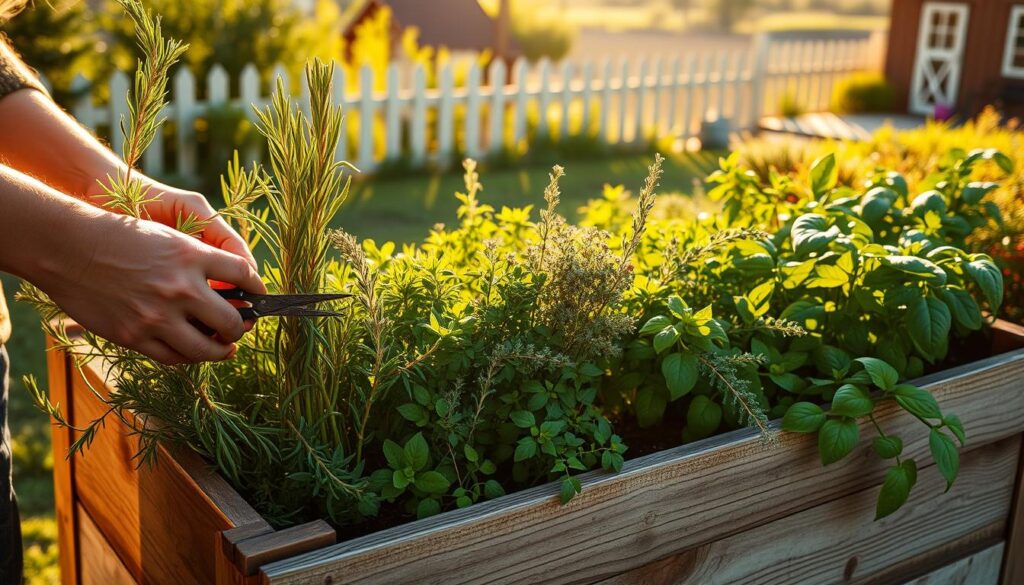
Most systems require no tools—just snap poles into connectors and slide bins into place. Align brackets carefully to prevent wobbling. One user shared: “I followed the diagram on page 3 of the manual—everything clicked together smoothly.” Tighten screws periodically if your model includes them, especially after moving the unit.
Effective Cleaning Techniques for Removable Bins
Empty bins after each harvest to refresh soil and prevent disease. Wash them with warm water and a mild, plant-safe soap. Avoid abrasive scrubbers that might scratch surfaces. For stubborn residue, soak bins for 10 minutes before rinsing.
Rotate bins seasonally to balance sun exposure for herbs like basil or mint. Check drainage holes monthly for clogs—use a toothpick to clear debris. Wipe frames with a damp cloth to maintain their finish.
| Task | Frequency | Tips |
|---|---|---|
| Bin Cleaning | After each crop | Use vinegar solution for mineral stains |
| Frame Inspection | Every 3 months | Check for loose connections |
| Soil Refresh | Seasonally | Mix in compost for nutrients |
Refer to the troubleshooting page included with your manual for leaks or uneven settling. Store spare parts in labeled bags—you’ll thank yourself later. With these habits, your herbs stay healthy, and your setup remains a centerpiece, not an eyesore.
How to Optimize Watering and Drainage Systems
Ever struggled with soggy soil or thirsty plants in your tiered setup? Proper hydration makes or breaks your greenery. Modern systems use smart engineering to balance moisture levels, whether you’re nurturing herbs indoors or veggies on a sunny patio.
Understanding Cascading Drainage Design
Water flows from the top tier to lower levels through angled trays and drainage holes. This mimics natural rainfall patterns while preventing root rot. One user noted: “My basil stays perfectly hydrated—no more guessing games!”
Follow these steps to maximize efficiency:
- Position the top planter slightly forward to direct runoff
- Check flow rates weekly using a cup test (collect overflow for 10 seconds)
- Add gravel layers in bins for heavy clay soils
| Issue | Quick Fix | Prevention Tip |
|---|---|---|
| Dry top tiers | Adjust drip emitter spacing | Use moisture-control soil |
| Pooling water | Clear clogged holes with a skewer | Install mesh screens |
| Uneven distribution | Rotate bins monthly | Level the frame |
Indoor home setups benefit from timed irrigation. Connect a smart valve to water during peak sunlight hours. Outdoor planters thrive with rain sensors that pause watering during storms.
Seasonal adjustments matter. Reduce flow by 30% in cooler months when evaporation slows. For planting mixes heavy in peat moss, increase drainage holes using a heated nail. Your system works smarter when you tailor it to your environment.
Integrating Vertical Gardens into Balconies and Patios
Your balcony or patio could become your next favorite room—with greenery climbing upward instead of spreading outward. Compact growing systems turn narrow ledges or blank walls into vibrant displays of herbs and blooms. Balcony spaces as small as 4’x6’ can host 20+ plants through smart vertical arrangements.
Space-Saving Benefits and Aesthetic Appeal
These setups do double duty: maximizing growing area while adding visual interest. Sleek metallic frames and modular tiers create living art pieces. One user transformed their fire escape into a culinary oasis: “I grow rosemary, thyme, and cherry tomatoes—all within arm’s reach of my kitchen window.”
Design strategies blend function with style:
- Use staggered tiers to cast shadows that hide AC units or railings
- Pair deep green foliage with bright gardens of pansies or petunias
- Opt for neutral-colored planters that complement outdoor furniture
| Feature | Balcony Setup | Patio Setup |
|---|---|---|
| Sun Exposure | 4-6 hours/day | 6-8 hours/day |
| Recommended Plants | Herbs, lettuce | Tomatoes, peppers |
| Assembly Time | Under 30 minutes | 45 minutes |
Ordering the right system simplifies the process. The UrbanBloom Compact Pro ships pre-assembled—just unfold and fill. Many retailers offer free virtual design consultations to help you plan layouts before placing your order.
For renters, freestanding units avoid permanent modifications. Rotate bins seasonally to keep your gardens thriving year-round. With smart planning, even a studio apartment’s balcony becomes a productive retreat.
Comparing Vertical Raised Garden Beds to Traditional Raised Beds
When space is limited, every planting decision matters. Modern growing solutions challenge traditional methods by maximizing vertical real estate—but how do they truly compare? Let’s explore which system delivers better results for urban growers and small-space enthusiasts.
Functional Differences and Layout Efficiency
Traditional setups spread horizontally, demanding 10+ sq. ft. for basic herb gardens. Stacked boxes in vertical designs use 75% less ground space while offering comparable planting area. One gardener noted: “I fit 24 strawberry plants where my old bed held just six.”
Maintenance differs dramatically. Ground-level beds require bending and weeding, while tiered systems position plants at waist height. Removable trays simplify root checks and pest control. A 2023 urban farming study found vertical users spent 42% less time on weekly upkeep.
| Feature | Vertical Design | Traditional Bed |
|---|---|---|
| Space Required | 2.5 sq. ft. | 10-15 sq. ft. |
| Assembly Time | Under 30 mins | 2+ hours |
| Watering Efficiency | Auto-drainage | Manual only |
| Material Quality | Rust-proof steel | Wood rot risk |
Drainage proves another advantage. Cascading systems prevent waterlogging—a common issue in flat beds. Powder-coated frames outlast untreated wood, with 89% of users reporting better durability over three seasons. As one review states: “No more replacing rotten boards every spring!”
Choose based on your priorities. Traditional beds work for large yards, while stacked boxes excel in tight spaces. Both require good soil quality, but vertical designs add convenience through ergonomic access and modular flexibility.
Expert Gardening Tips for Maximizing Plant Growth
Growing thriving plants in limited spaces demands smart strategies. By combining expert techniques with real-world user insights, you’ll unlock fuller harvests and healthier blooms—no matter your setup’s size.
Tailored Approaches for Herbs, Vegetables, and Flowers
Herbs like basil and mint thrive in upper tiers with 6+ hours of sunlight. Use well-draining soil mixed with perlite to prevent soggy roots. One gardener notes: “Rotating my rosemary weekly ensures even growth without leggy stems.”
Leafy greens prefer lower levels with partial shade. For tomatoes or peppers, position them at eye level where airflow reduces disease risks. Flowers like marigolds benefit from strategic spacing—crowding limits bloom production.
| Plant Type | Soil Depth | Water Needs |
|---|---|---|
| Herbs | 6-8 inches | Light, frequent |
| Vegetables | 10+ inches | Deep, 2x weekly |
| Flowers | 8-10 inches | Moderate |
Applying Community Wisdom to Your Routine
User reviews reveal game-changing patterns. Many emphasize steel frames’ durability: “My system stayed sturdy through three Midwest winters.” Others suggest lining bins with coconut coir to retain moisture during heat waves.
- Add slow-release fertilizer pellets every 60 days
- Use drip trays to protect indoor floors from water runoff
- Clean materials biannually with vinegar solutions
Adjust based on your plants’ signals. Yellow leaves often mean overwatering—check drainage holes for clogs. For leggy growth, increase light exposure or rotate bins daily. Your compact system becomes smarter when you listen to both experts and fellow growers.
Innovative Design Trends and Accessories in Vertical Gardening
Your growing setup can reflect your personal style while boosting functionality. Modern accessories transform practical structures into eye-catching displays that match your decor. From sleek metallic finishes to clever organizational tools, today’s upgrades blend aesthetics with smart growing solutions.
Exploring Color Options, Plant Labels, and Upgrade Bundles
Choose frames in matte black, sage green, or terracotta to complement outdoor furniture. Neutral tones create calm backdrops for vibrant blooms, while bold hues make standalone statements. One user noted: “The bronze finish ties my patio set together—it looks intentional, not just functional.”
Labeling systems keep herbs and veggies organized. Magnetic tags attach directly to bin edges, while engraved markers slide into soil. Popular styles include:
- Weatherproof acrylic labels with chalkboard surfaces
- Reusable silicone tags color-coded by plant type
- Miniature LED markers for nighttime identification
Upgrade bundles offer tailored support for specific needs. The Urban Grower Pro Kit includes:
| Feature | Standard | Upgraded |
|---|---|---|
| Planting Bins | 4 included | +2 stackable bin add-ons |
| Labels | Basic plastic | Custom metal tags |
| Stability | Fixed legs | Adjustable support brackets |
Pair accessories strategically. Use dark-colored bins for heat-loving peppers and light hues for shade-preferring mint. Rotate decorative labels seasonally to keep your setup fresh. With thoughtful upgrades, your garden becomes both productive and Instagram-worthy.
Conclusion
Modern horticulture meets compact living through intelligent space solutions. Tiered planters prove you don’t need sprawling yards to grow fresh flavors or vibrant blooms. With durable steel frames and cascading drainage, these systems turn narrow balconies into lush oases while using under three square feet of floor space.
Integrated self-watering networks simplify maintenance, delivering moisture precisely where roots need it. Strategic tier placement lets you optimize sunlight exposure—position herbs higher for full rays while shielding shade-tolerant greens below. One user achieved 14 lineal feet of planting in a corner previously occupied by a recycling bin.
The right setup adapts to your lifestyle. Rotate modular bins as seasons change or move lightweight stands indoors during frost. Drip trays protect floors while angled designs prevent water waste. Whether nurturing basil or begonias, you’ll appreciate how smart engineering supports healthier growth.
Ready to transform unused corners? Prioritize units with powder-coated metals and adjustable sunlight management. Your compact growing journey starts here—where every inch works harder so you reap more.

